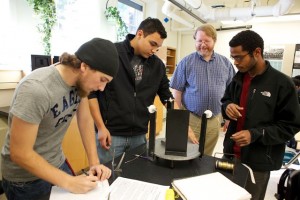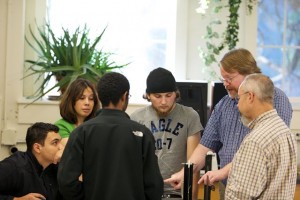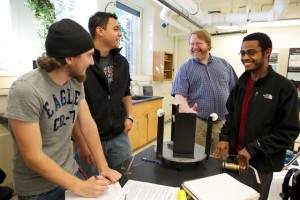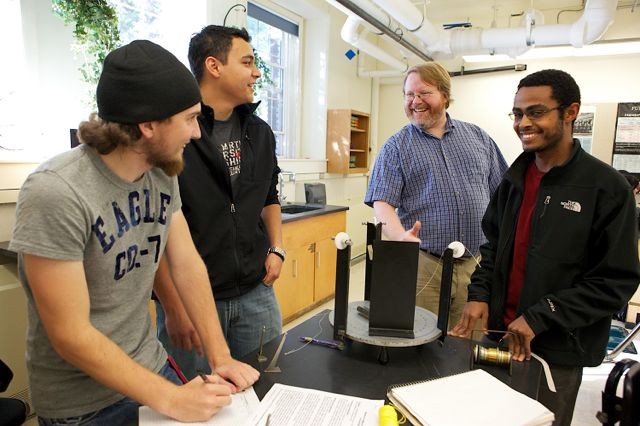 The physics students of today are tomorrow’s scientists, engineers, medical doctors, high school teachers and college professors. Even economists, psychologists, writers, and many other future professionals often take an introductory course in physics. A basic knowledge of physics is a key component of a well-rounded education.
The physics students of today are tomorrow’s scientists, engineers, medical doctors, high school teachers and college professors. Even economists, psychologists, writers, and many other future professionals often take an introductory course in physics. A basic knowledge of physics is a key component of a well-rounded education.
Saint Martin’s University boasts of engaging physics classes that encourage students of various disciplines to think differently about problem solving. This approach is attributed to the two physics professors, Dr. Stephen Parker and Dr. John Weiss, who have brought an enthusiastic, active learning and accessible teaching methodology into a challenging course of study.
Saint Martin University’s physics classes consist largely of engineering students as well as those majoring in chemistry or biology. Currently, Saint Martin’s University does not offer a physics minor or major. However, Drs. Parker and Weiss are hoping to change that. Dr. Parker comments that with the addition of Dr. Weiss within the last year, they now have the faculty depth to teach a greater number of higher level physics courses, which he explains “will lead more immediately to a minor in physics. Hopefully as our numbers grow and we start getting more people interested in the wonders of physics, this might lead to an eventual physics major at the university.”
Dr. Parker further explains that Saint Martin’s has a new Engineering Building (Cebula Hall). “We have many people who come to Saint Martin’s to become mechanical and civil engineers, who typically take physics during their freshman year. I, along with my mathematics colleagues, help them learn what it will be like to be in a Science, Technology, Engineering and Math (STEM) field, and hopefully, give them the foundational knowledge they will need to succeed in their engineering classes. “
 “Chemistry and biology majors are also required to take two semesters of introductory physics. Although branches of chemistry and biology can rely more and more on the fundamental principles of physics as they advance in their field, one of the most important lessons I feel I can impart to these students is how to ‘think logically’ about problem solving,” adds Parker. “The ability to figure out what you know and then what you can do with it to solve a problem is a critical skill in science and these skills are honed during their physics classes.”
“Chemistry and biology majors are also required to take two semesters of introductory physics. Although branches of chemistry and biology can rely more and more on the fundamental principles of physics as they advance in their field, one of the most important lessons I feel I can impart to these students is how to ‘think logically’ about problem solving,” adds Parker. “The ability to figure out what you know and then what you can do with it to solve a problem is a critical skill in science and these skills are honed during their physics classes.”
“One of my goals is for students to become better writers when explaining their solutions,” adds Dr. Weiss. “I hope that they’ll almost reflexively use verbal explanation to support their figures and mathematics.”
The growth in the Saint Martin’s physics department has not only allowed for expansion of more upper-level physics classes, but also physics classes geared towards the non-scientists such as Dr. Weiss’s class on the development of physics and astronomy from the Greeks forward. “Teaching students how to think in a different way is a large part of what a liberal arts education is about. Physics teaches non-scientists to make data-based and quantitative arguments, something that I think is vitally important to our society,” says Dr. Weiss.
Another opportunity for students to “think differently” will occur this spring when Dr. Weiss co-teaches a class traveling to Paris and Florence. He explains, “We’re focusing on the history of science and the connection between science and culture. The trip is aimed at science majors, a group that is often underrepresented in study-abroad trips. We plan to read some of Galileo’s writings, but we’ll also discuss the history of art and the science of food. I think it’ll be an excellent exposure for the science majors to see their disciplines in a broader historical and cultural context.”
 For those staying on campus completing upper-level physics courses such as classical and computational mechanics, Dr. Weiss has the students building and modeling trebuchets. He explains, “They’ll be made out of toys, but they’ll be functional and we’ll have a contest to see how accurate they can be and how far they can fling their projectiles.”
For those staying on campus completing upper-level physics courses such as classical and computational mechanics, Dr. Weiss has the students building and modeling trebuchets. He explains, “They’ll be made out of toys, but they’ll be functional and we’ll have a contest to see how accurate they can be and how far they can fling their projectiles.”
Also on campus is the well-attended “Sunday Night Tutoring” for physics where as many as half of the students taking introductory physics show up. It is an opportunity to work on homework with each other and get help from the student tutors or one of the physics professors. Dr. Parker states, “They have been hugely successful, with the students who attend always saying they get a lot out of them. It is one way we help our students through what can often be a difficult subject.”
There is an obvious commitment to the study of physics yet there is an equal commitment to teaching at a small school like Saint Martin’s. Dr. Parker shares, “I love the interaction with the students that the small school environment brings. Being able to see the ‘I finally get it’ on their faces after struggling with some physics concept is one of the reasons I became a teacher in the first place. I wanted to teach where I could make connections with all the students. I love playing intramural sports with the students and being able to get involved with various activities around campus, from the Frisbee Golf Club to International Education Week. It’s the students of Saint Martin’s that makes my job so enjoyable.”





















































